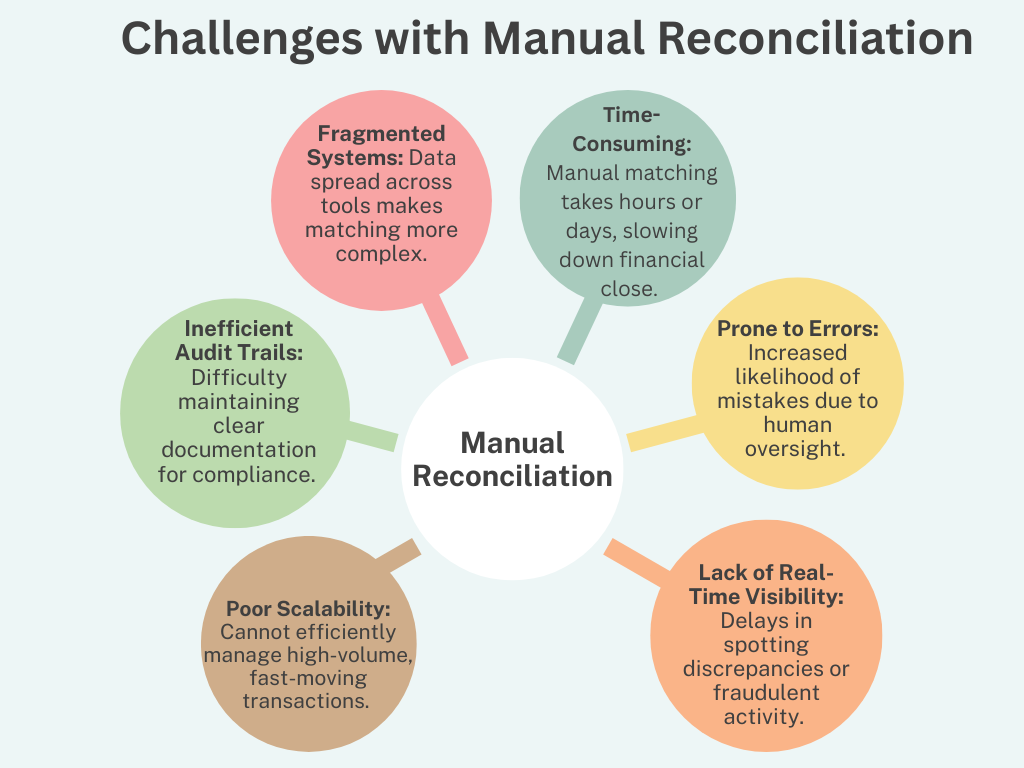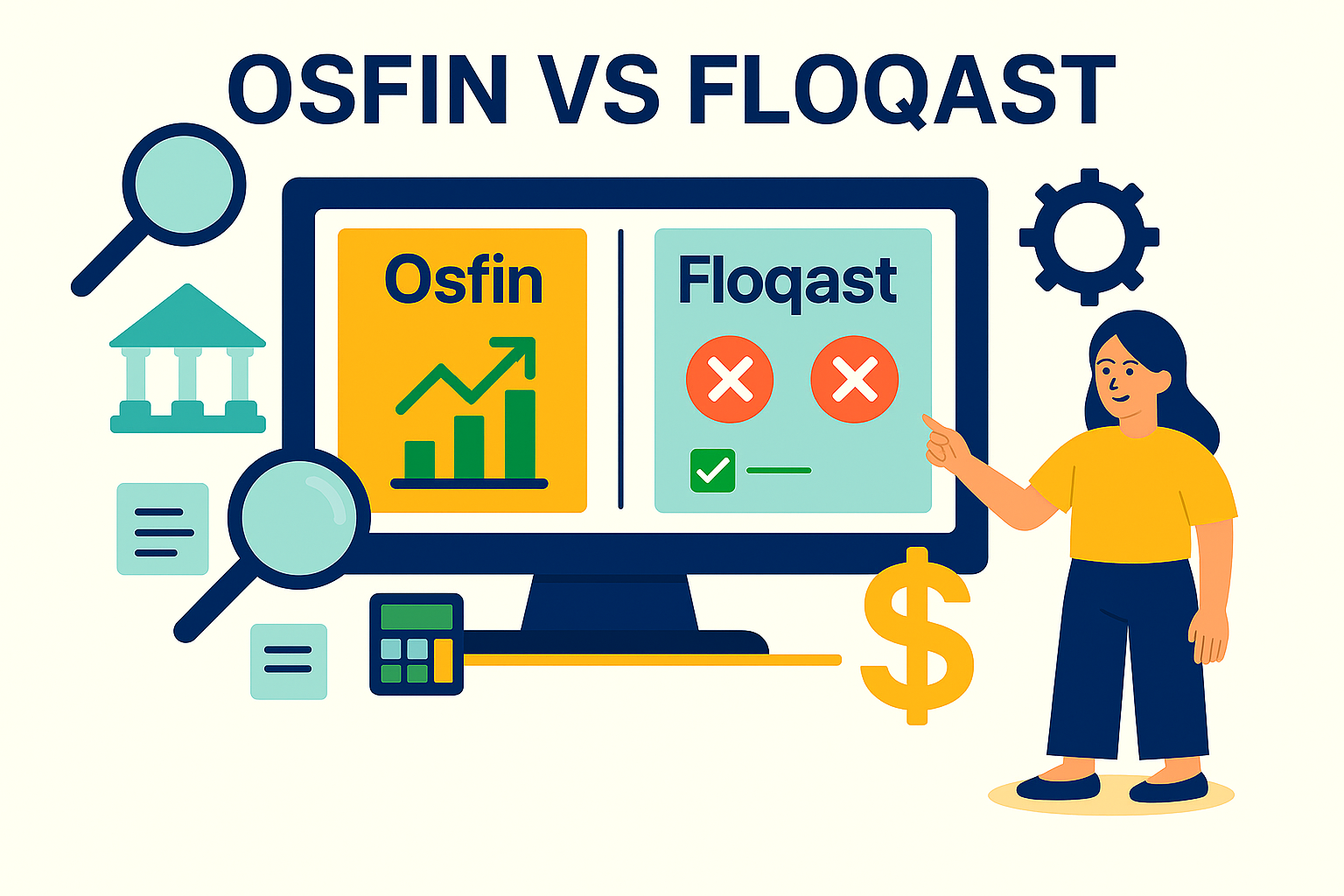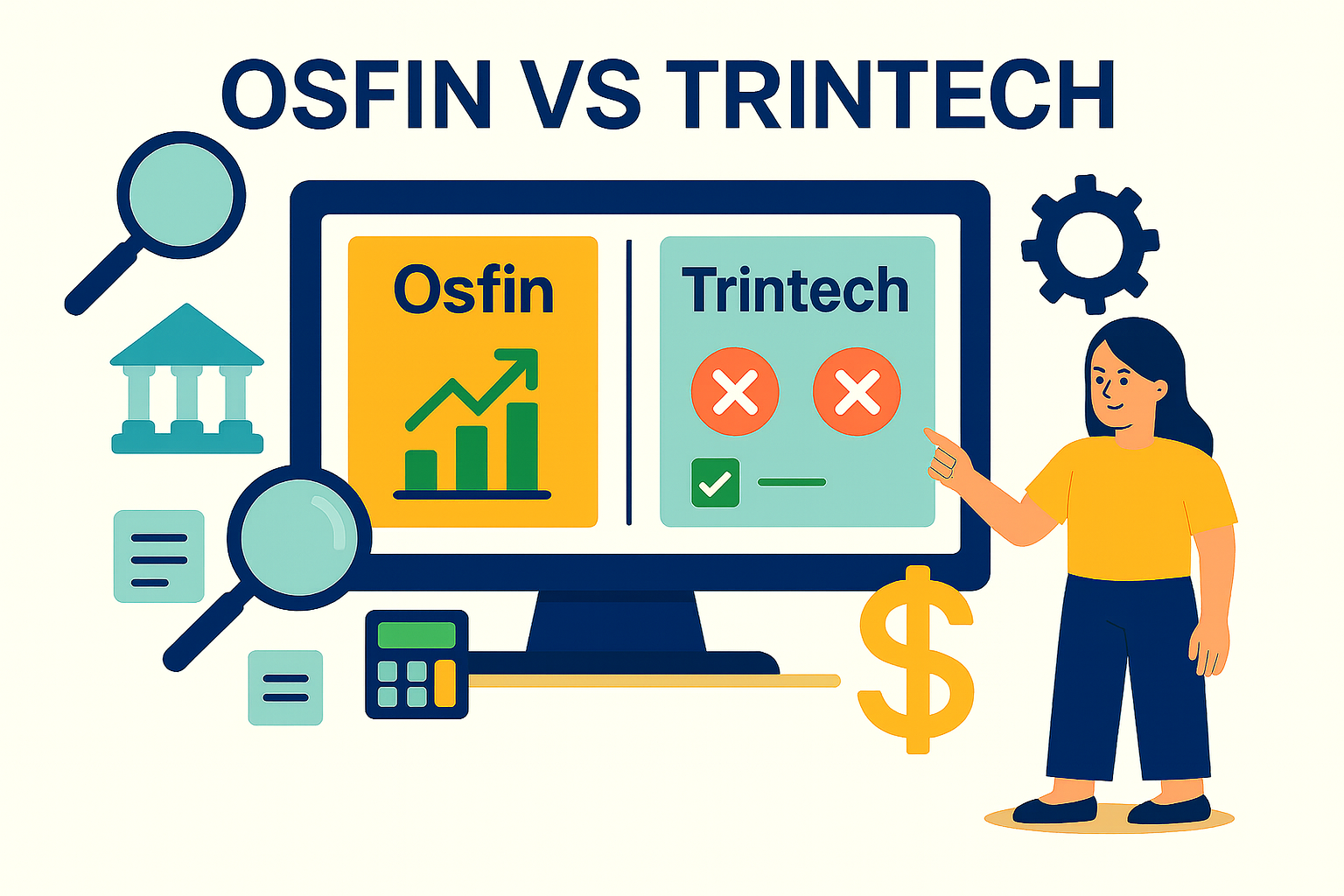What Are Reconciling Items? Definition and Examples
Recent studies reveal that finance teams spend 30% of their time on manual bank reconciliation tasks, significantly reducing their capacity for analysis and strategic work. This wastes valuable resources and increases the risk of inaccuracies and delays in financial reporting.
Managing accurate financial records is critical for making effective business decisions. There are, however, discrepancies between internal books and other external documents such as bank statements. Such inconsistencies, which are generally referred to as reconciling items, can hinder reporting and reduce compliance, and, if overlooked, will lead to erroneous financial statements.
While reconciling items is a routine part of accounting, it often comes down to minor data entry errors and timing differences. Still, they can escalate into serious financial and compliance problems if unresolved.
This article explains reconciling items, why they occur, their impact, and how tools like Osfin can help automate and manage them effectively.
What this blog covers:
- What reconciling items are in financial reconciliation and why they occur
- Common types of items: timing differences, unrecorded entries, bank charges, manual postings
- How reconciling items impact close cycles, audit readiness & accuracy
- Best practices for tracking, investigating & resolving reconciling items
- How automated reconciliation software (like Osfin) helps manage reconciling items at scale
What Are Reconciling Items?
Reconciling refers to the short-term differences or errors between a bank's internal ledger records and external financial documents, such as customer transactions and clearing house reports. These miscellaneous items emerge in the reconciliation process; they usually arise from timing mismatches, processing delays or manual entry errors. Identifying and fixing the reconciling items is essential to maintain ledger accuracy, ensure regulatory compliance, and uphold overall financial integrity.
Some common examples of reconciling items are as follows:
Deposits in Transit
The bank has received and recorded cash but has not yet been reflected in the client's internal records. These are timing differences and do not involve journal entries.
Outstanding Checks
The client issued checks that have not yet cleared through the bank's system, resulting in pending outbound payments.
Non-Sufficient Funds Checks
Customer-issued checks bounced due to insufficient funds, requiring the bank to reverse the original credit to the client’s account.
Bank Fees and Charges
The bank applied charges such as account maintenance or wire processing fees, which have not yet been recorded in the client's internal accounts.
Interest Income
The bank has credited interest accrued on the client's deposits, but it has yet to be updated in the client's books.
Reconciling Item Definition in Accounting
In accounting, reconciling items are the differences between a company's internal financial records, i.e., the general ledger, and the external records, i.e., bank statements or vendor bills. Timing errors or recording errors cause such discrepancies. They should be recognised in the reconciliation process to ensure the accuracy and credibility of the company's financial accounts.
Importance of Reconciliation in Financial Management
An essential control tool in financial management is reconciliation, since it helps to compare internal books with external records. It helps maintain financial integrity by checking irregularities before they escalate into bigger problems.
Here’s why reconciliation is essential for sound financial operations:
Accuracy and reliability
Reconciliation ensures the financial records are complete and represent the real business activity. This identifies discrepancies during the data entry or missing transactions that could otherwise distort financial statements.
Fraud, Prevention and Risk Control
Through regular accounts reconciliation, organisations can detect unauthorised or suspicious transactions. This early warning measure strengthens against fraud and builds internal financial controls.
Regulatory Compliance
Most regulatory frameworks require periodic reconciliation to guarantee data transparency and integrity. When proper reconciliation is carried out, it supports compliance with accounting standards, tax laws and the audit requirements, thus reducing the risk of penalties.
Improving Cash Flow and Liquidity Control
After adjusting deposits in transit, outstanding checks and returned payments, reconciliation clarifies the actual cash available. This allows informed decisions regarding payables, investments and operating expenses.
Common Types of Reconciling Items
Reconciling items occurs due to timing, and some due to errors or omissions. It is essential to know their type to perform an appropriate reconciliation promptly in each financial closing cycle.
The most common types of reconciling items include:
Timing Differences
These occur when a transaction has been recorded in the company’s books but has not been recognised in external records, like the bank statements. Examples include deposits in transit and outstanding checks. Although they tend to resolve over time, it is essential to be able to track and provide consistency.
Transaction errors and omissions
Financial records can get altered by mistake, such as double-entry or non-payment purchases. For example, a deposit of 10,000 can be registered as 1,000 dollars, leading to a difference of 9,000 dollars that must be adjusted to get an accurate report.
Bank-Initiated Transactions
Banks can post entries such as charges, interest credits or NSF (Non-Sufficient Funds) checks without notice. Such unrecorded adjustments lead to a change in the balance unless updated in the general ledger on time.
Other Ledger Discrepancies
Internal and external records may also get mismatched by vendor payment mismatches, customer receivables, stale-dated checks, and intercompany transactions. Identifying and correcting these ensures clean, audit-ready books.
Real-World Reconciling Items Examples
Bank reconciliation is essential regarding matching such ledgers as being on the books to actual correspondence of transactions made on the payment systems, or at the level of the correspondent’s banks, or customer accounts. Timing problems, processing delays or transactional mismatches are some of the reasons behind discrepancies.
Some major reconciling items in bank reconciliation are:
Transit Deposits
Internal systems recognise the incoming funds, but have not been settled or shown in the records of the clearing bank or the payment processor because of settlement cycles.
Outstanding Checks
These are outflows that the bank or financial institution has already recorded but have not debited the client's account because the checks are not yet presented or cleared.
Non-Sufficient Funds Checks (NSF)
Spoiled checks or unsuccessful direct debit due to a lack of money in a payer's account must be corrected with corrections and tracked in the debt book.
Bank Charges and Interest Receipts
Commission taken, service charges or interest released by the bank to account for the payment, but not yet updated and reconciled on downstream systems of reconciliation or treasury.
These reconciling items must be identified and resolved as soon as possible to maintain the accuracy of these transactions, comply and offer the clients trustworthy financial reporting.
Reconciling Items in Bank Reconciliation
Bank reconciliation helps to match a company's internal cash records and external bank statements. Several everyday reconciling items often explain the difference between the two balances.
Key reconciling items in bank reconciliation are:
Deposits in Transit
They are the deposits recorded in the company’s accounts but have not yet been received in the bank account. This is usually due to processing delays.
Outstanding Checks
The difference is that the balance is temporarily caused by uncashed checks, issued by the company but not yet cashed by the recipients.
Non-Sufficient Funds Checks
Customer checks were deposited into the account but rejected due to insufficient funds; these entries should be reversed and updated in accounts receivable.
Bank Charges and Interest Income
Fee charges on maintenance or ATM fees only appear in the bank statements. Similarly, interests earned must be incorporated into internal books.
Correcting these reconciled items is how to review financial reporting and get the real cash position.
Challenges with Manual Reconciliation

Manual reconciliation often struggles with delays, errors, and low cash flow visibility. It struggles to handle high volumes of transactions, and the complexity of financial processes usually leads to inefficiencies and a higher risk of errors.
Significant challenges of manual reconciliation are:
High Risk of Error
Financial errors occur due to outdated and incompatible records and the misinterpretation of transactions. These mistakes can lead to poorly informed business decisions.
Time-Consuming Processes
Manual completion of transaction matching is a time-consuming process; it impacts and slows monthly close-cycles, financial reporting and decision making.
Non-Standardisation
Reconciliations can vary across teams without the uniformity of processes. Such a discrepancy can make audits tricky and increase the risk of non-compliance.
Limited Fraud Detection
Manual processing lacks real-time tracking and automatic checks, which makes it difficult to identify suspicious and fraudulent activities on time.
Scalability Issues
Manual reconciliation is ineffective in handling large volumes, multiple currencies and high-volume international payments, resulting in operational inefficiencies.
{{banner1}}
Best Practices for Managing Reconciling Items
The process of reconciliation of the items in banks and financial institutions needs to be systematised, subjected to periodic monitoring, and supported by the appropriate technology stack. Such practices help shorten the reconciliation cycles, increase accuracy, and improve control over funds.
Adhere to a Uniform Reconciliation Calendar
Introduce a daily or monthly reconciliation routine, depending on the number of transactions. In companies engaging in high-frequency transactions, such as neobanks or payment processors, real-time or daily reconciliation allows them to minimise backlog cases and identify discrepancies in less time.
Automated reconciliation tools: Leverage Tools
Apply automation to align transactions in bank statements or internal ledgers and third-party reports. Modern systems can pick up on variances, indicate mismatches and produce audit-ready reports, thus lessening manual labour and error possibility.
Clear Documenting and Audit Trails Maintain
Note all the reconciliation items and add supporting documents, i.e. payment confirmation letters, etc. Documenting the nature of how every item was addressed enables transparency and makes internal audits and regulatory checks much easier.
Train Operations and Finance Departments
Train reconciliation teams regularly to know how to detect frequent mismatches, read payment reports, and implement suitable resolution processes. Properly trained teams do reconciliation only faster and with minimal possible adjustments.
Check Unpaid Transactions and Arrears of Payment
Monitor ongoing settlements such as pending inward/outward payments and late remittances. Follow-ups are timely, so there is no collection of out-of-date items, and the right insights are achieved by treasury and cash flow teams reporting on liquidity.
Why Reconciling Items Matter in a Real-Time Finance Stack
Instant reconciliation enhances accuracy as errors are instantly detected, requires less human oversight, and maintains clean records to make compliant reporting. It removes lags and ensures the reliability of financial information.
It increases efficiency in the operations, speeds close cycles, automates AP/AR processes, and eliminates manual disconnects, saving time and easing the finance and operations staff.
Teams can improve decision making, solve problems early, predict well and remain compliant with good insights. The risk management is also enhanced by the real-time detection of anomalies that safeguards the financial integrity of the institution.
{{banner2}}
How Osfin Automates Reconciling Item Management
Manual handling of reconciling items is time-consuming, prone to human error and cannot be easily expanded. Automation will help make resolution faster and more precise, and increase the control of finance teams on reconciliation across systems. That’s where Osfin steps in.
Osfin.ai is an efficient, automated reconciliation that can be applied to complex financial operations. It is fast-built, large-scale, and accurate and simplifies reconciliation across various data sources with perfect accuracy, control and compliance.
Key Features of Osfin.ai:
- Data Ingestion: Accepts any file format, integrates with 170+ systems, detects outliers and duplicates, and applies custom deviation tolerances to ensure clean, reliable data.
- Matching Engine: Uses logic-based matching to support one-to-many and many-to-many reconciliation, handling up to 30 million records in under 15 minutes.
- Gateway Reconciliation: Automatically reconciles payment gateway reports, including commission, tax, and fee breakdowns.
- Exception Handling: Flags unmatched records, assigns clear reasons, and routes them to the right team members through live dashboards showing match status, exposure, and exception queues.
- Secure and Audit-Ready Output: Generates encrypted, audit-ready compliance reports with SOC 2, PCI DSS, ISO 27001, and GDPR adherence, along with role-based access and two-factor authentication.
{{banner3}}
FAQs on Reconciling Items
What is an Accounting Reconciliation Item?
A reconciling item is a disparity between two financial records, which might be temporary, and should be identified and solved as part of the reconciliation process to provide the correct and consistent financial reporting.
How should Automation help in the Management of Reconciling Items?
By automating, businesses eliminate human error, accelerate transaction matching, and gain real-time access to the list of discrepancies. This allows the teams to address reconciling items in no time and ensure the quality of financial backing.
How frequently should the Reconciliation be made to Facilitate Reconciling Items?
The frequency of reconciliation is related to the volume of transactions. Daily or weekly reconciliation is done when the business is high volume, and other companies may have a monthly scheme to avoid the accumulation of discrepancies in the end.
What does Osfin do to enhance the Process of Reconciling Items?
Osfin auto reconciles with AI and real-time exception tagging and can create custom workflows. It provides credible data and smooth audits within the record, saving time and providing complete visibility for all financial systems.


